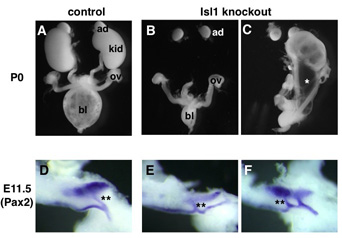
Yusuke Kaku, Tomoko Ohmori, Kuniko Kudo, Sayoko Fujimura, Kentaro Suzuki, Sylvia M. Evans, Yasuhiko Kawakami, and Ryuichi Nishinakamura
(2013) Islet1 deletion causes mouse kidney agenesis and hydroureter resembling CAKUT
J. Am. Soc. Nephrol. Epub ahead of print
Islet1 (Isl1) is a transcription factor transiently expressed in a subset of heart and limb progenitors. During studies of limb development, conditional Isl1 deletion produced unexpected kidney abnormalities. Here, we studied the renal expression of Isl1 and whether it has a role in kidney development. In situ hybridization revealed Isl1 expression in the mesenchymal cells surrounding the base of the ureteric bud in mice. Conditional deletion of Isl1 caused kidney agenesis or hypoplasia and hydroureter (Figure A-C) , a phenotype resembling human congenital anomalies of the kidney and urinary tract (CAKUT). The absence of Isl1 led to ectopic branching of the ureteric bud out from the nephric duct or to the formation of accessory buds (Figure D-F), both of which could lead to obstruction of the ureter-bladder junction and consequent hydroureter. The abnormal elongation and poor branching of the ureteric buds were the likely causes of the kidney agenesis or hypoplasia. Furthermore, the lack of Isl1 reduced the expression of Bmp4 , a gene implicated in the CAKUT-like phenotype, in the metanephric region before ureteric budding. In conclusion, Isl1 is essential for proper development of the kidney and ureter by repressing the aberrant formation of the ureteric bud. These observations call for further studies to investigate whether Isl1 may be a causative gene for human CAKUT.

Figure Islet1 deletion causes mouse kidney agenesis and hydroureter.
A-C: The newborn (P0) kidneys. Isl1 KO shows kidney agenesis (B) and hydrouretr (C).
* dilated ureter; ad: adrenal gland; bl: bladder; kid: kidney; ov: ovary.
D-F: whole mount in situ hybridization of Pax2 at embryonic day 11.5. The position of the ureteric bud **) is shifted toward the cranial side (left side in the panel E). Duplicated ureteric buds are shown in panel F.